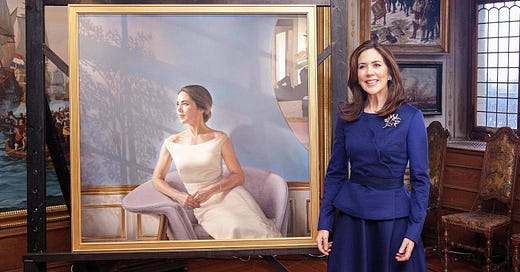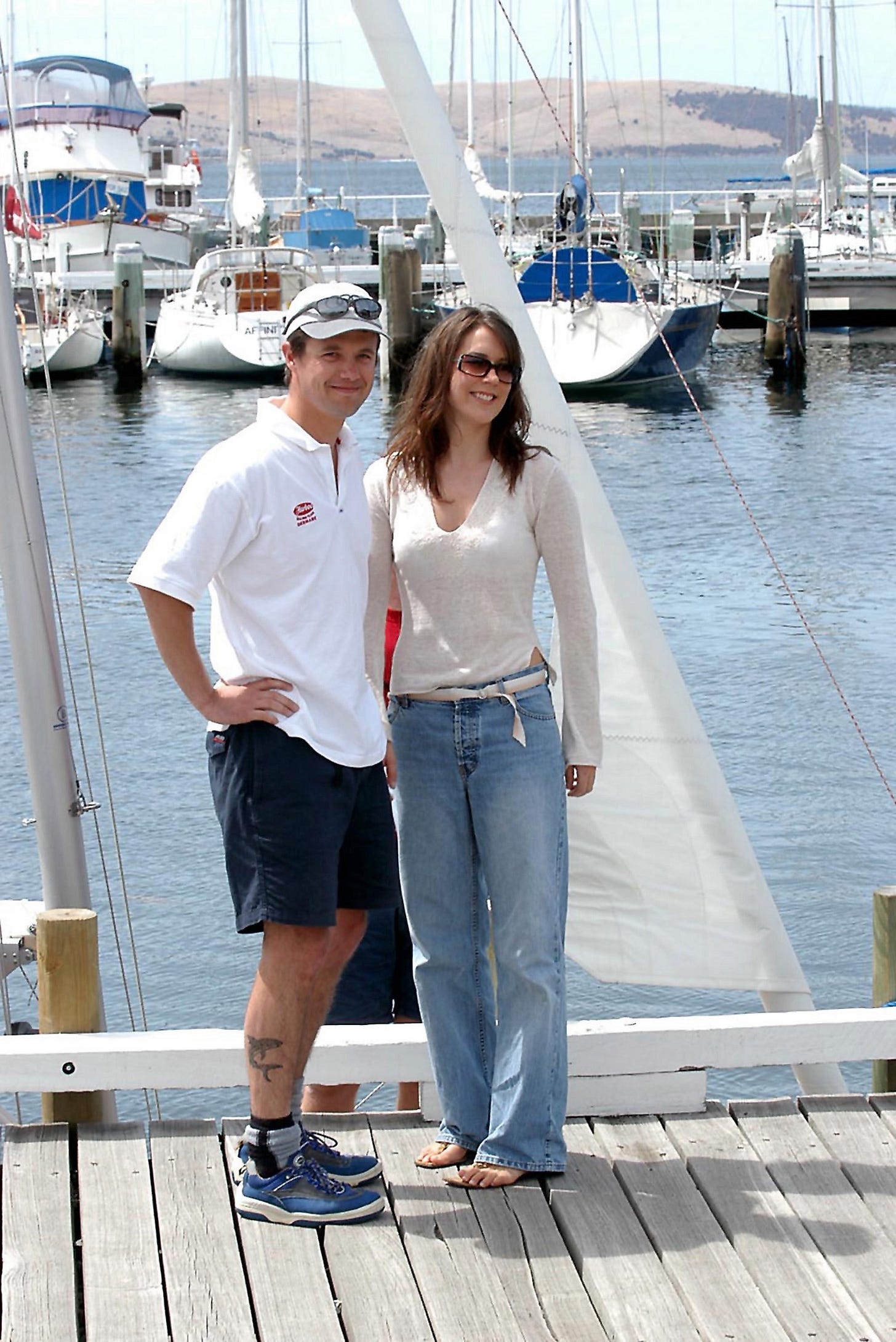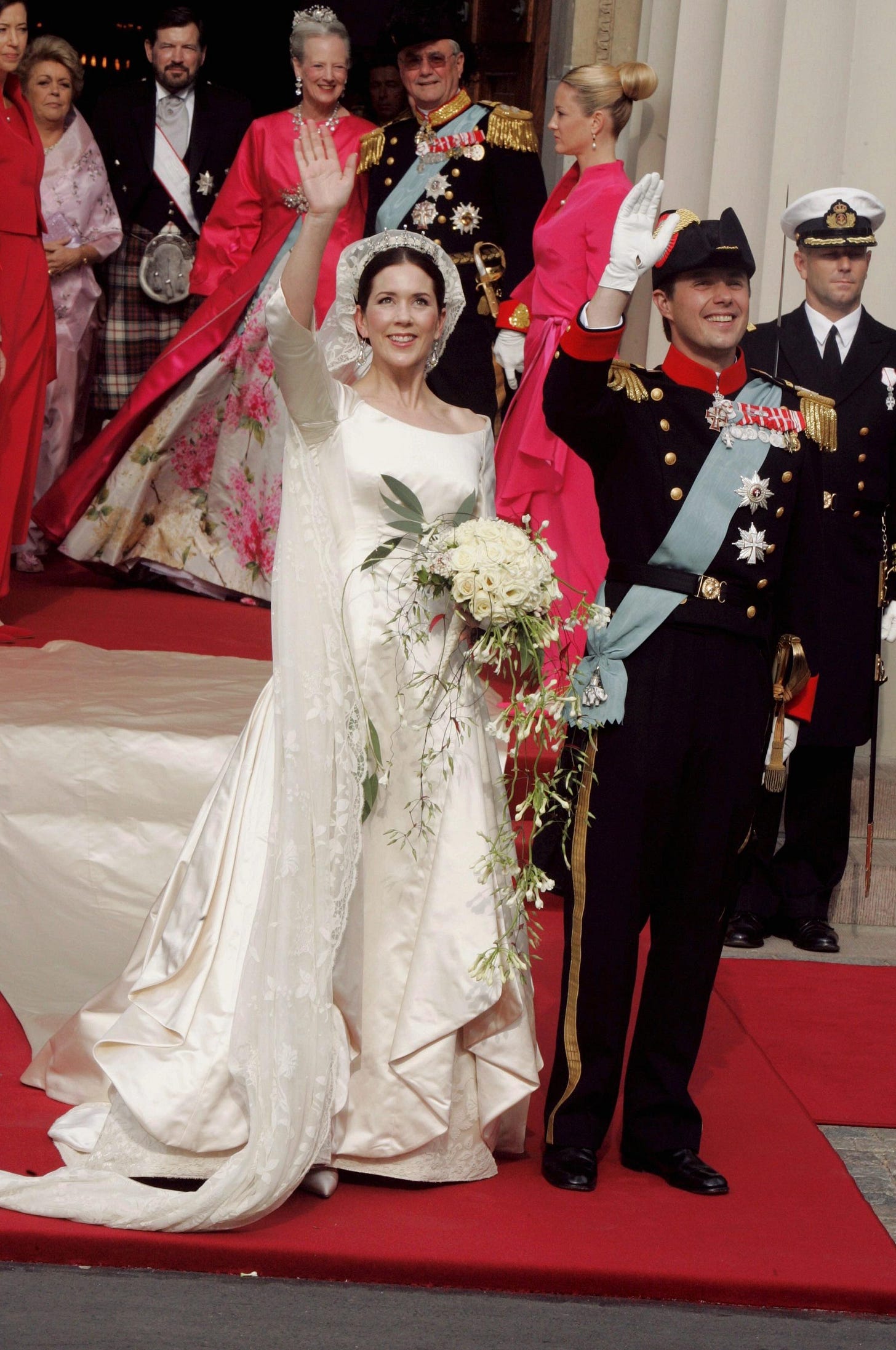Spotlight on Denmark’s Crown Princess Mary and the Danish Royal Family
As the Duchess of Cambridge visits the Scandinavian country, a look at its future queen (and the woman who has been dubbed Kate’s doppelgänger!)
Welcome to So Many Thoughts, a semi-weekly newsletter about royal style and the other parts of life I want to think through with you. You can subscribe here and follow me on Instagram at @EHolmes. Thank you!
Hello! How are you? I am sorry to say the Queen and I both have COVID at the moment. Wishing Her Majesty a speedy recovery.
The Duchess of Cambridge is on a solo two-day tour of Denmark this week, taking her early childhood development work abroad for the first time. Kate stepped out Tuesday in a red blazer and white blouse, channeling — you guessed it! — the Danish flag. The most memorable moment of the day was her trip down the slide at the Lego Foundation PlayLab in Copenhagen. “In the spirit of where I am, I had to do it,” she said afterwards.
On Wednesday, Kate will meet with the Danish Royal Family, including Queen Margrethe II and Crown Princess Mary. *So many* comparisons have been made between Kate and Mary, in a way that feels quite complimentary rather than competitive. Beyond their similar appearances and fashion aesthetics, the two are both commoners who will one day be queens of their respective countries. They are also hands-on mothers who share a love of the outdoors and sports. Mary feels almost like a big sister, one step ahead of Kate on her royal journey.

Given Kate’s visit and Mary’s recent (and utterly fabulous) 50th birthday portraits, I thought it would be the perfect time to take a look at the crown princess. And what a story she has! Australian-born Mary Donaldson met her prince… at a bar. So grab a cup of tea and join me for a bit of background on the couple affectionately known as Fred and Maz. (Plus, you are going to want to hear about the drama between the Danish queen and her husband who wanted to be king.)
Much like my primer on Queen Letizia of Spain, I hope this can be a jumping off point to discuss Mary more. And, as always, I would love to hear what you think! Please hit “Join the Discussion” at the bottom of this email and leave a comment on my Bulletin page.

Who is Mary, Crown Princess of Denmark?
Mary, Crown Princess of Denmark is the 50-year-old wife of Crown Prince Frederik, heir to the Danish throne. Together the couple have four children: Christian (age 16), Isabella (14), and twins Vincent and Josephine (11).
When both Queen Margrethe II and Crown Prince Frederik are abroad, Mary can act as regent, an honor bestowed upon her in 2019. She will be the first Australian-born queen consort in Europe when her husband becomes king.
Let’s start with a bit about the Danish Royal Family.
Margrethe II is Queen of the Kingdom of Denmark, which is made up of Denmark, Greenland and the Faroe Islands. Denmark is its most populous country, with about 5.8 million people (for a sense of scale, that is less than a tenth of the population of the United Kingdom).
The Danish monarchy is thought to be among Europe’s oldest, with the official website of Denmark tracing back the current queen’s heritage more than a thousand years. It is also quick to paint its modern royal family in a relatable light:
Today's Danish monarchy doesn't spend a lot of time on pomp or circumstance. The children of the Royal Family attend ordinary public schools, and the adult members of the family are often seen shopping, dining, or riding their bicycles in public just like any other Dane.
They seem to be quite proud of their low profile. As Mary told the Sydney Morning Herald back in 2013: “You can cycle through town and nobody shouts, ‘Look, it’s the Princess.’ They are used to seeing us. Some people come up and say hello and that’s fine. It’s no big deal.”
What can you tell us about the current Danish Queen?
Margrethe II became queen in 1972 at the age of 31, the first female Danish Sovereign in nearly three centuries. She was the eldest of three daughters born to Frederik IX of Denmark and Ingrid of Sweden of the House of Glücksburg. It took a constitutional amendment, passed in 1953, to allow a woman to inherit the throne. This year Margrethe will celebrate her golden jubilee, marking 50 years on the throne.
Today, the 81-year-old queen, nicknamed Daisy, enjoys tremendous popularity — upwards of 80% — among the Danes. The BBC describes her as “an accomplished artist and a heavy smoker.” She is quite the student, too, studying philosophy at Copenhagen University, earning a degree in archeology from the University of Cambridge and later attending the London School of Economics. She speaks five languages fluently: Danish, English, French, Swedish and German.
Margrethe is said to be an admirer of Queen Elizabeth II’s, particularly her commitment to her duties. (And yes, they are related; as descendants of Queen Victoria, Margrethe and Elizabeth are third cousins.) In an interview with the BBC timed to Margrethe’s jubilee in 2012, she called her role “not a life sentence, but a life of service.”

And what’s this about her husband wanting to be king?
In 1967, Margrethe married a Frenchman named Henri, Count of Laborde de Monpezat. When she became queen a few years years later, her husband became Henrik, Prince Consort of Denmark. But Henrik wanted to become king consort. (Traditionally a king has a queen consort, but a queen has a prince consort since “king” outranks “queen”). Margrethe denied that request from her husband, as well as his desire to be called “Your Majesty.”
“The title he wanted didn’t exist; there was no precedent. She could have created a title, but she didn’t want to,” a Danish television correspondent told the New York Times, calling Margrethe “stubborn.” (Was she, though?)
Henrik held the grudge for decades. “Teased for his French accent and unable to understand why protocol required him to remain in his wife’s shadow, Henrik never really found his place in Denmark,” read the Guardian's obituary, quoting Henrik as once saying: “A lot of people think I’m a loser until I prove them wrong.” (Makes you appreciate Prince Philip a bit more, doesn't it?)
In 2017, the palace communications chief said Henrik had decided not be buried next to his wife:
“It is no secret that the prince for many years has been unhappy with his role and the title he has been awarded in the Danish monarchy. This discontent has grown more and more in recent years. For the prince, the decision not to buried beside the queen is the natural consequence of not having been treated equally to his spouse – by not having the title and role he has desired.”
That fall, the prince was diagnosed with dementia, according to the Guardian; a few months later, he was hospitalized with a lung infection. When he passed away in 2018, Prince Henrik was cremated. Half of his ashes were buried in a private garden at Fredensborg Castle and the other half scattered over Danish waters.
But all love was not lost between the prince and his queen. In planning his funeral, the prince arranged for one final grand gesture for his wife. Henrik asked that the flowers be arranged on the floor as if in a garden. It was a nod to the speech he had made to Margrethe at their wedding, which the bishop quoted during Henrik's funeral: “I came from a country of flowers into a blossoming garden,” he said in 1967. “But the girl, however, was the garden’s single most beautiful adornment.”
Ok, back to Mary. What was her pre-royal life like?
Mary Elizabeth Donaldson was born on February 5, 1972 in Hobart, Tasmania, Australia. She is the youngest of four children of Henrietta, a university secretary, and John Donaldson, a math professor. Her parents emigrated to Australia from Edinburgh in 1963, which meant Mary had dual Scottish and Australian citizenship.
And would you believe she has a Texas connection? Mary began her schooling at Clear Lake City Elementary School in Houston while her father was working at the Johnson Space Center. But the bulk of her childhood, and her education, was in Australia. She attended University of Tasmania, graduating with a bachelor’s degree in commerce and law in 1994. She worked in advertising for years, according to the royal family website. But after the death of her mother, from a heart condition in 1997, Mary began traveling around the world.
“It happened too early,” the princess said of her mother’s passing in an interview earlier this year with Eurowoman, translated via Vanity Fair. Mary was just 25 years old at the time. “It’s so hard to see when it is so close and so personal, but as you get older, you learn to appreciate the time you had together as a gift. And the loss offers something that you wouldn’t have otherwise. It makes a strong person.”
In 2001, Mary’s father remarried Susan Horwood, the British crime novelist who writes under the name Susan Moody.
And how about Crown Prince Frederik?
Born on May 26, 1968, Frederik André Henrik Christian is the oldest of Margrethe and Henrik’s two sons. His mother became the queen when he was just three, which meant he has lived nearly his entire life as her heir. “I didn’t have much to do with my parents until I was 21,” he said in a 2009 interview with Parade magazine. “When I was small, I was presented to them, washed and brushed, before I was put to bed.”
His education included stints at a French boarding school and Harvard, where he studied political science as “Frederik Henrikson.” He earned his master’s degree in the same field from University of Aarhus in Denmark.
Fred, as he is known, earned the nickname “Turbo Prince” because of his adventurous spirit. He served in one of the most elite units of the Danish military, the Royal Danish Navy Combat Swimmer Corps. He is said to love diving, sailing, and running; in 2013, he completed the Copenhagen IronMan.
“He is extremely popular. He is like a rockstar in Denmark,” a Danish columnist told Australia’s 60 Minutes in 2003. A decade later, the Sydney Morning Herald called him “a doll — funny, disarmingly open and a bit fidgety, like a schoolboy who would rather be out in the playground.”
How did Mary meet Fred?
In September 2000, during the Summer Olympics in Sydney, 28-year-old Mary Donaldson met her 32-year-old prince at a bar. The Sydney Morning Herald suggested the prince was “reveling in his Sydney anonymity” at the a pub called the Slip Inn when the two struck up a conversation:
“The relationship is said to have begun rather inauspiciously with a light-hearted discussion of the merits or otherwise of hair on the male chest, of which Frederik is devoid.”
Can you even! (Fun fact: then-Crown Prince Felipe, future king of Spain, was also there that night, too.) Mary had no idea who she was talking to at first. “It was perhaps half an hour or so later that someone came up to me and said, ‘Do you know who these people are?’” she said during their engagement photo call.
“I wasn’t the only crown prince in that crowd that evening,” the prince quipped in response.
A long-distance relationship ensued, with all-hours phone conversations. The pair kept their courtship a secret for more than a year before a Danish magazine reported their relationship in November 2001, making Mary a paparazzi target. (The blog Mary from the Start has pictures from that time.) The first public outing for the couple didn’t come until January 2003, nearly two and a half years after they first met. By then, Mary had moved closer — first to Paris and then to Copenhagen. But it was back home in Australia that Fred and Mary gave cameras a first glimpse of their affection for one another. On the deck of the Tasmania Yacht Club, with Fred in baggy shorts and Mary in wide-leg jeans, they exchanged a brief kiss.
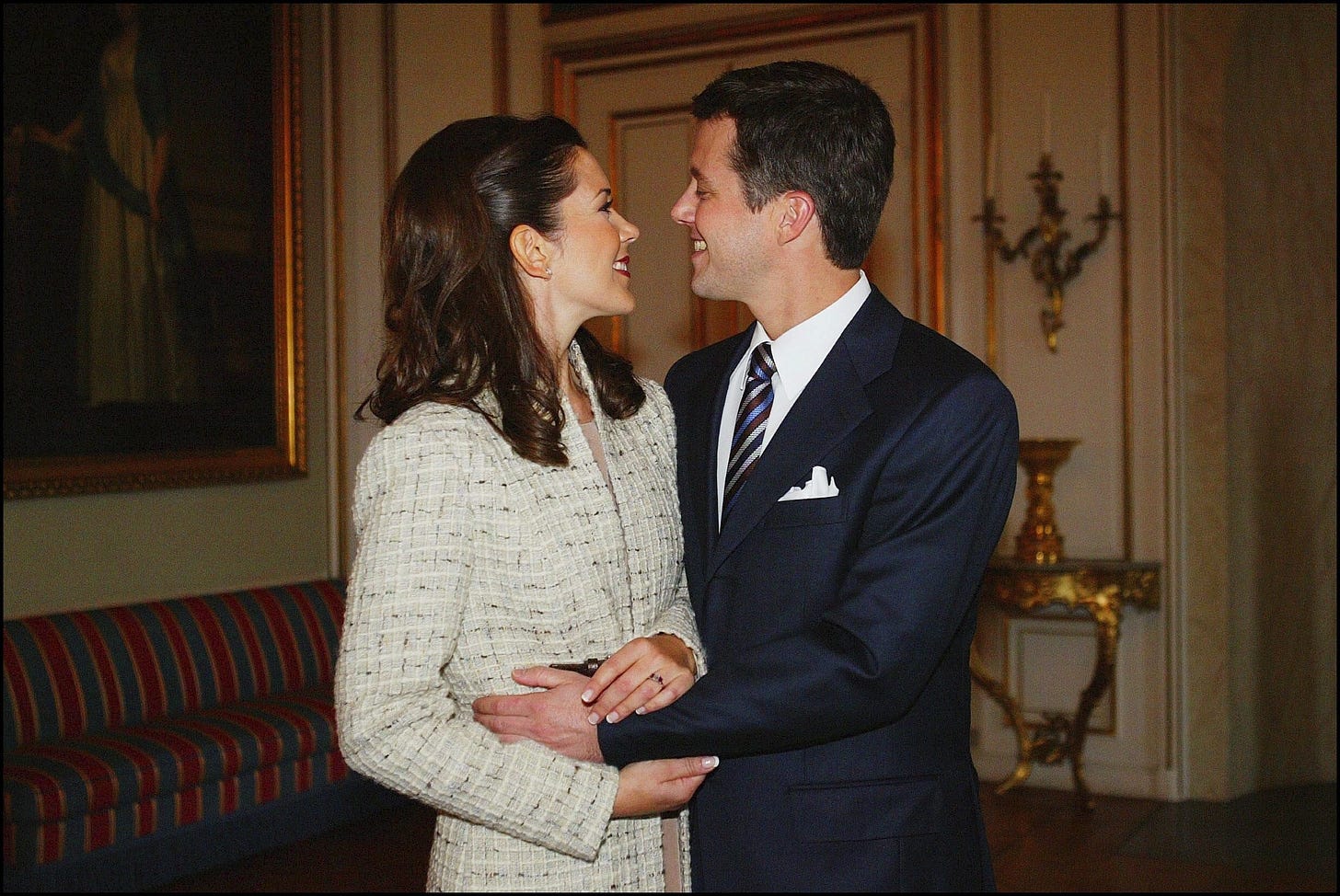
When did Fred and Mary announce their engagement?
In the fall of 2003, five months after Queen Margrethe publicly acknowledged the relationship, the palace announced Fred and Mary’s engagement. He was 35 at the time, she was 31. The crown prince helped design the ring himself. Inspired by the Danish flag, it features a central emerald-cut diamond flanked by a pair of rubies.
You can watch clips from their engagement interview here. They divulge very few details about the proposal itself, with Fred mumbling things like: “There was just some good sort of vibe” and “some fun and happiness.”
I did appreciate this insight from Mary: “What is the perfect princess? It’s very subjective. All I can say is I will fulfill the role in a way that is very particular to me. And that all I can do is work hard and do my best,” Mary said.
How was Mary received by the Danish public?
Both the Danes and the Aussies seem to be pleased with this union from what I’ve read. Media in both countries celebrated the news. “The immigrant princess is not only the choice of the Crown Prince’s heart, she also has the approval of the Danes,” read a piece in the Copenhagen-based daily newspaper Berlingske Tidende.
However, there was quite a lot that the Aussie bride-to-be had to forgo — and embrace — as the wife of the future King of Denmark. At the time of their engagement, she gave up any right to her future children in case of divorce. (How scary would that be?) She also had to give up her Australian citizenship and convert from her Presbyterian faith to the Danish Lutheran Church. She studied up on Danish society, history, and politics, and vowed to learn the language.
Two weeks before their wedding, the couple also signed a prenuptial agreement, which removed any right Mary had to Fred’s assets before the marriage, as well as any property in the kingdom of Denmark. But if they were to divorce, Fred would be obligated to provide Mary with the home of her choice anywhere she chose to live, as well as monthly alimony and a lump-sum payment.
Let’s talk about their wedding!
More than 180 million viewers tuned in worldwide to watch Crown Prince Frederik marry Mary Donaldson on May 14, 2004 at the Copenhagen Cathedral. (You can watch the wedding here.) Mary wore an off-the-shoulder white duchesse satin gown with a six-meter train by Danish designer Uffe Frank. The tiara was a gift from her new in-laws, a delicate diamond piece that nearly disappeared under her voluminous updo and statement veil. The century-old Irish lace used to make Mary’s veil was first used by Crown Princess Margaret of Sweden in 1905 and again by Queen Margrethe at her wedding in 1967. The lace also featured in the dramatic folds of the gown’s full skirt, which was lined with 30 meters of tulle. The designer said the partial sleeves were meant to resemble calla lilies.
Mary’s father, John, walked her up the aisle in a Scottish kilt. Her late mother was included in the day, too; Mary had her mother’s wedding ring sewn into the bodice of her dress near her heart and had her bouquet taken to Scotland to rest on her mother's grave after the wedding.
The reports of the ceremony and reception gush with the romance on display between the couple. Mary was quite stoic from what I have seen, but Fred! Fred was feeling all the feelings. The groom wiped away tears as his bride walked up the aisle and later he gave a heartfelt speech at the reception. “The joy and strength you give me is like the sun in the daytime, which with its radiance melts all doubt and darkness on earth,” he said. “I love you Mary. Come, let us go, come let us see. Throughout a thousand worlds, weightless love awaits.”
The reception included “a marriage feast marked by tears of joy and passionate kisses” and revelry until after midnight, according to the write-up in the Sydney Sun Herald. “Indeed, the celebration will go down as one of the most romantic and emotional royal weddings in history.”

Tell us about their brood.
Mary and Fred welcomed their first child on October 15, 2005. Per Danish royal tradition, his name wasn’t announced until the christening a few months after the birth. But everyone already knew what their first born son would be called: Prince Christian. Since the 16th century, with the reign of King Frederik I, male heirs to the Danish throne have alternated between the first names Frederik or Christian. (Crown Prince Frederik is expected to be King Frederik X.)
Princess Isabella was born on April 21, 2007, with the middle names “Henrietta Ingrid Margrethe” for both her grandmothers. Twins Prince Vincent and Princess Josephine Sophia Ivalo Mathilda were born on January 8, 2011.
The family splits its time between two residences: Frederik VIII’s Palace at Amalienborg and Chancellery House at Fredensborg Palace.
Where has Mary focused her attention as a working royal?
Mary's embrace of progressive social issues has earned her the nickname the “Danish Diana.” She launched The Mary Foundation in 2007, which focuses on bullying and well-being, domestic violence, and loneliness. “Its inspiration largely originates from The Crown Princess’ social work with patronages, where social isolation in particular often proves to be one of the key causes behind the problems,” the website reads.
Health is another signature issue of the crown princess's. She is patron of the World Health Organization Regional Office for Europe and more than a dozen other health-related organizations, including groups focused on heart health, maternal health, mental health and twin research. I admire how her work reaches beyond the Kingdom of Denmark; in 2013, she became Patron of Twins Research Australia.
The crown princess has also been a leader as a royal advocate for LGBTI+ rights. In 2016, she gave a speech at the IDAHO forum on International Day Against Homophobia and Transphobia.
“All human beings are born free and equal in dignity and rights, regardless of sexual orientation and gender identity. But that assertion, for far too many around the world, does not hold true,” she said. “Too many LGBTI people continue to be victims of hatred, violence, discrimination, bullying and ill-treatment — and this we cannot and must not accept.”
Mary became the first royal patron of Copenhagen2021, which the website called “the greatest and most inclusive LGBTI+ event ever to be held in Denmark.”
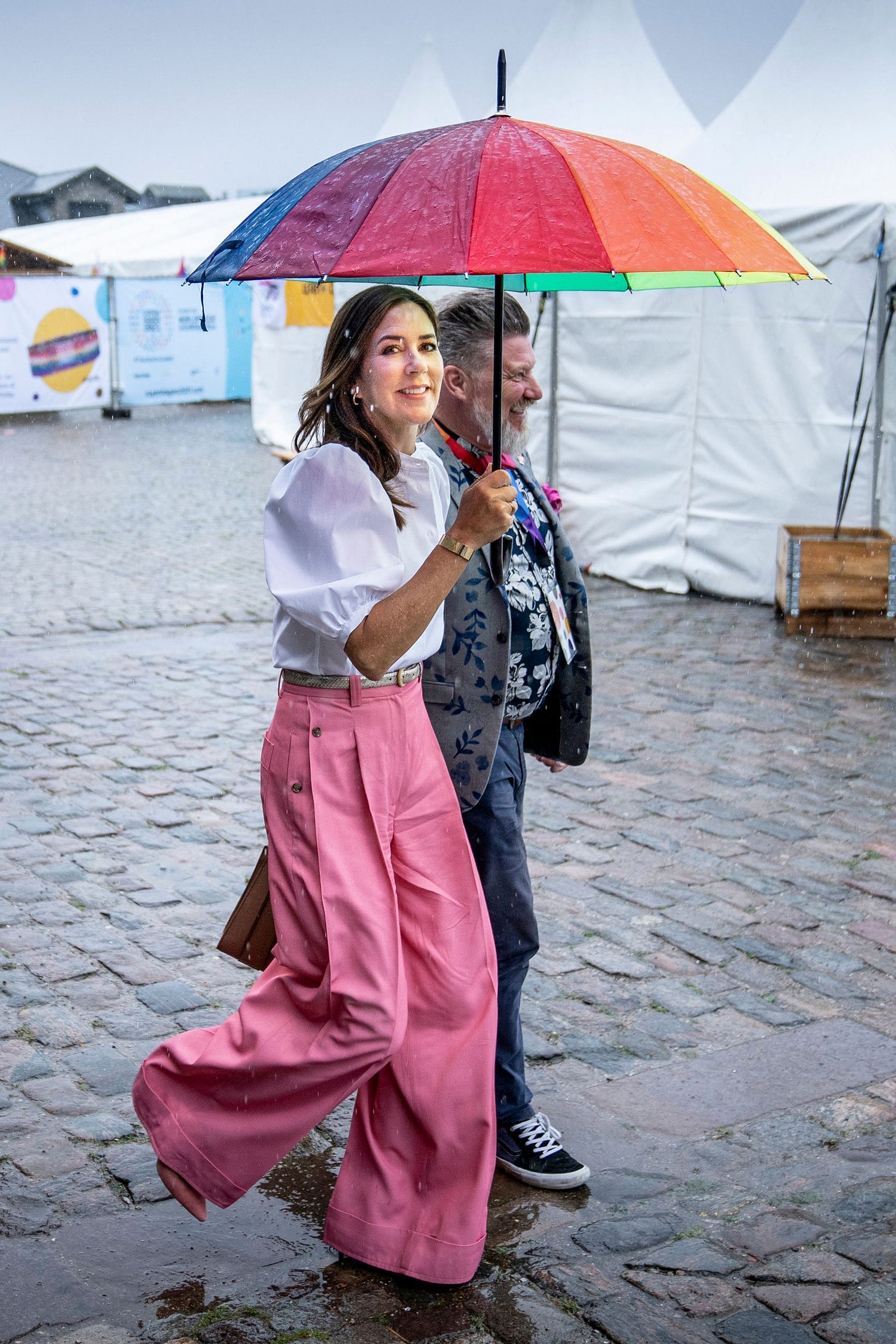
And what about her fashion?
The crown princess tends towards feminine, colorful, tailored pieces — much like the Duchess of Cambridge. Mary also has some absolutely incredible gowns. Shoutout to the Instagram accounts that have compiled these fun side-by-side montages of Mary and Kate’s twinning moments ahead of their meeting this week. (Tap and scroll through below!)
“Very early on, it was clear that there were expectations about what you wore and how you dressed appropriately to an event,” Mary told the Financial Times in an interview this year, reflecting on her royal tenure. “That was pretty daunting for me. I was a T-shirt-and-shorts girl, known to go barefoot.” The attention, she added, isn’t always welcome. “At times it can feel frustrating that what you’re wearing can overshadow the cause at hand,” she said. “But I’m sensing and hoping that there’s a shifting focus, that there’s less focus on the outer than there has been.”
As patron of Global Fashion Agenda since 2009, Mary has long championed a sustainable approach to style. I particularly love her remarks from a 2020 interview with the group, demonstrating how she thinks about clothes:
“If you look at the way we are consuming fashion today, we are seeing a much greater market for second hand, for recycled, upcycled. This is another value, because it tells a history of the product…what impact has it had in its production, in its life, on the environment, how much waste has been used in making this product, and the people making it. Were they treated fairly? Consumers are beginning to see more and more that value is much more than the price on the ticket.”
In 2021, she outlined the need for specific steps in her speech to open the Copenhagen Fashion Summit: “Textile waste must be reduced, the use of recycled fibers must be increased, efficiency must be optimized and the use of natural resources minimized.”
Mary walks the walk! She has repeated and reworked her gowns over the years, altering the construction or fiddling with the styling. And it looks like she is priming the next generation. According to Royal Fashion Police on Instagram, her daughter Isabella wore her Paul Smith double-breasted tuxedo from 2019 to an event earlier this year.
We can’t close without talking about Mary’s 50th birthday!
I have to say, I absolutely adore how Mary WENT FOR IT with her recent 50th birthday. She embraced this milestone with such gusto. The fantastic portraits (and fashion!) just kept coming.
She set the stage with a series of Cinderella-esque shots, featuring an ice blue shimmery dress and her ruby tiara. One of the shots is featured on the cover of a new book of photographs of the princess called “Mary HKH.”

There was also the unveiling of a new painted portrait, which is now on display at the National History Museum at Frederiksborg Castle in Hillerød as part of an exhibition to mark her birthday. And the family released a new casual series of pictures, too, in matching white button downs. An interview the crown princess gave to the Financial Times came with its own set of striking shots. The purple suit — SWOON! So here for this.
Once again, I have to cut myself off! More on Mary and her fashion to come down the road. Until then, I am excited to see her appearance with Kate.
What do you think about Crown Princess Mary? Hit “Join the Discussion” at the bottom of this email and leave a comment on my Bulletin page. You can also send me an email at hello@somanythoughts.com.
Like what you’re reading? Please forward this to a friend! My newsletter comes out twice a week, covering royal news on Fridays and more general style topics on Tuesdays. You can subscribe here, read past issues here, and find me on Instagram at @EHolmes.

